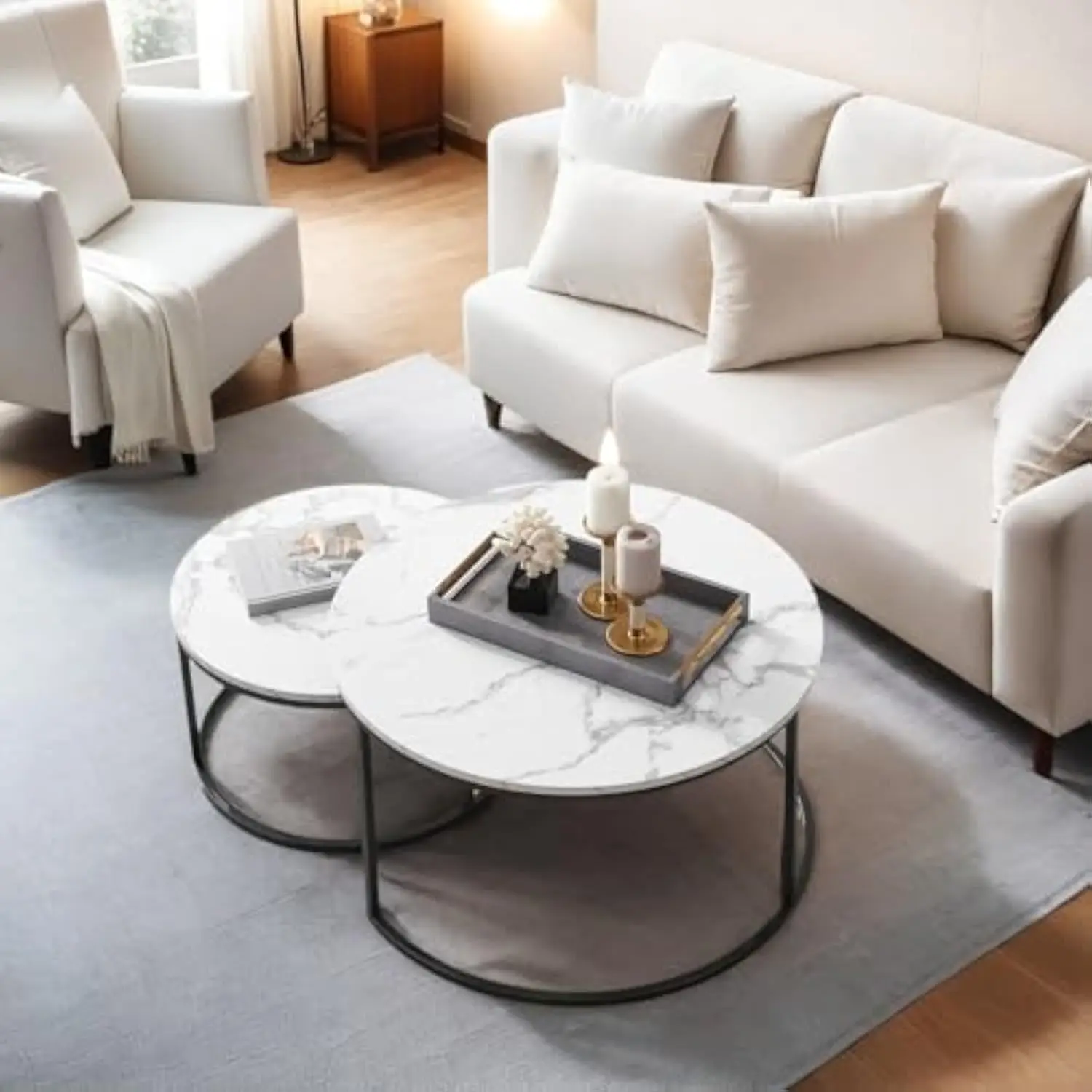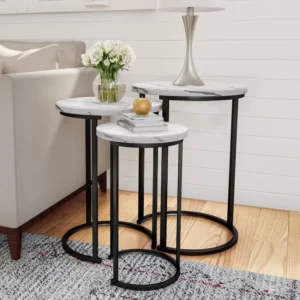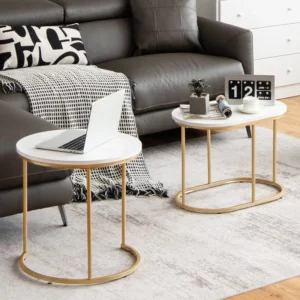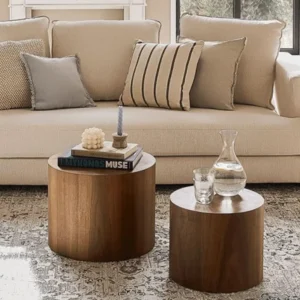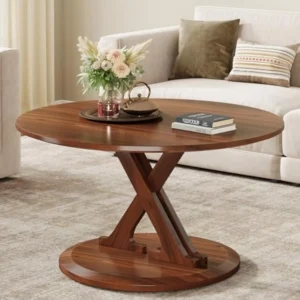Understanding Space-Efficient Nesting Tables
Nesting tables are ingeniously designed furniture sets featuring multiple tables of graduated sizes that fit one under another for compact storage. This clever design concept allows you to maximize your available space while still enjoying the functionality of multiple surfaces when needed. The space-saving potential is impressive—a typical set of three nesting tables can reduce the footprint by up to 70% when stored compared to three individual tables.
What makes these tables truly special is their thoughtful construction. Each table in the set is carefully proportioned to slide seamlessly beneath the next larger one, creating a single, unified piece when not in full use. This space efficiency doesn’t come at the expense of style or functionality—quite the opposite.
For anyone dealing with limited square footage, understanding the key features of space-saving nesting coffee tables becomes essential for making smart furniture choices. These versatile pieces embody the perfect balance of form and function, particularly evident in mid-century modern nesting table sets that combine authentic design principles with practical space management.
Whether you’re furnishing a compact apartment or simply want to maximize your living area, the right nesting tables can transform how you use your space while adding a touch of sophisticated design.
I. Space-Saving Design Features: The Foundation of Nesting Tables
The true brilliance of nesting tables lies in their fundamental design. The nesting mechanism relies on precise measurements and proportions—each smaller table must have enough clearance to slide completely under the larger one while maintaining structural integrity. This careful engineering ensures smooth transitions between configurations without wasted space.
When fully nested, a standard set of three tables typically occupies only the footprint of the largest piece—about 24-36 inches in diameter or length. Compare this to three separate tables that would require approximately three times the floor space, and the advantage becomes immediately apparent. For instance, a set of three rectangular nesting tables might take up just 3 square feet when nested but provide 9 square feet of usable surface area when fully deployed.
The impact on room layout and traffic flow can’t be overstated. These tables allow you to:
- Instantly adapt to changing needs (entertaining guests vs. everyday living)
- Clear floor space for activities when tables aren’t needed
- Reconfigure your room without moving heavy furniture
- Maintain comfortable walking paths through tight spaces
For those living in apartments or small homes, these design features aren’t just nice-to-have—they’re essential. The ability to maximize small spaces with nesting coffee tables transforms how you can live in and enjoy compact environments. The thoughtful engineering behind these pieces makes them a cornerstone of smart small-space design.
When properly selected, nesting tables become a space-saving solution that doesn’t feel like a compromise, but rather an elegant answer to the challenge of limited square footage.
II. Material Selection and Its Impact on Space Efficiency
The materials used in nesting tables dramatically affect both their functional space efficiency and how spacious a room feels visually:
Glass/Acrylic Features:
– Creates visual spaciousness through transparency
– Allows light to flow through, making rooms feel up to 30% larger
– Reduces visual weight and clutter
– Reflects light to brighten smaller spaces
– Maintains strength while appearing delicate
Glass tops are particularly effective in tight spaces, as seen in many mid-century modern glass top coffee tables that combine visual lightness with sturdy construction.
Metal Features:
– Enables exceptionally slim profiles while maintaining structural integrity
– Provides strength without visual bulk
– Offers clean lines for contemporary aesthetics
– Allows for interesting leg designs that minimize visual footprint
– Often weighs less than solid wood alternatives, improving mobility
Wood Features:
– Brings warmth and natural elements to small spaces
– Can be crafted with tapered or thin profiles
– Offers versatility in style from traditional to modern
– Provides visual weight for balance in minimalist spaces
– Creates tactile contrast in mixed-material designs
Mixed Material Combinations:
– Glass tops with metal frames maximize visual spaciousness
– Wood and metal combinations balance warmth with slim profiles
– Layered materials create visual interest without requiring additional space
– Contrasting materials help define each piece when nested or separated
The material choice affects not just the physical space the tables occupy, but how we perceive the room around them. Lighter, more transparent materials create breathing room in tight quarters, while strategic use of wood can add necessary visual anchoring without overwhelming the space.
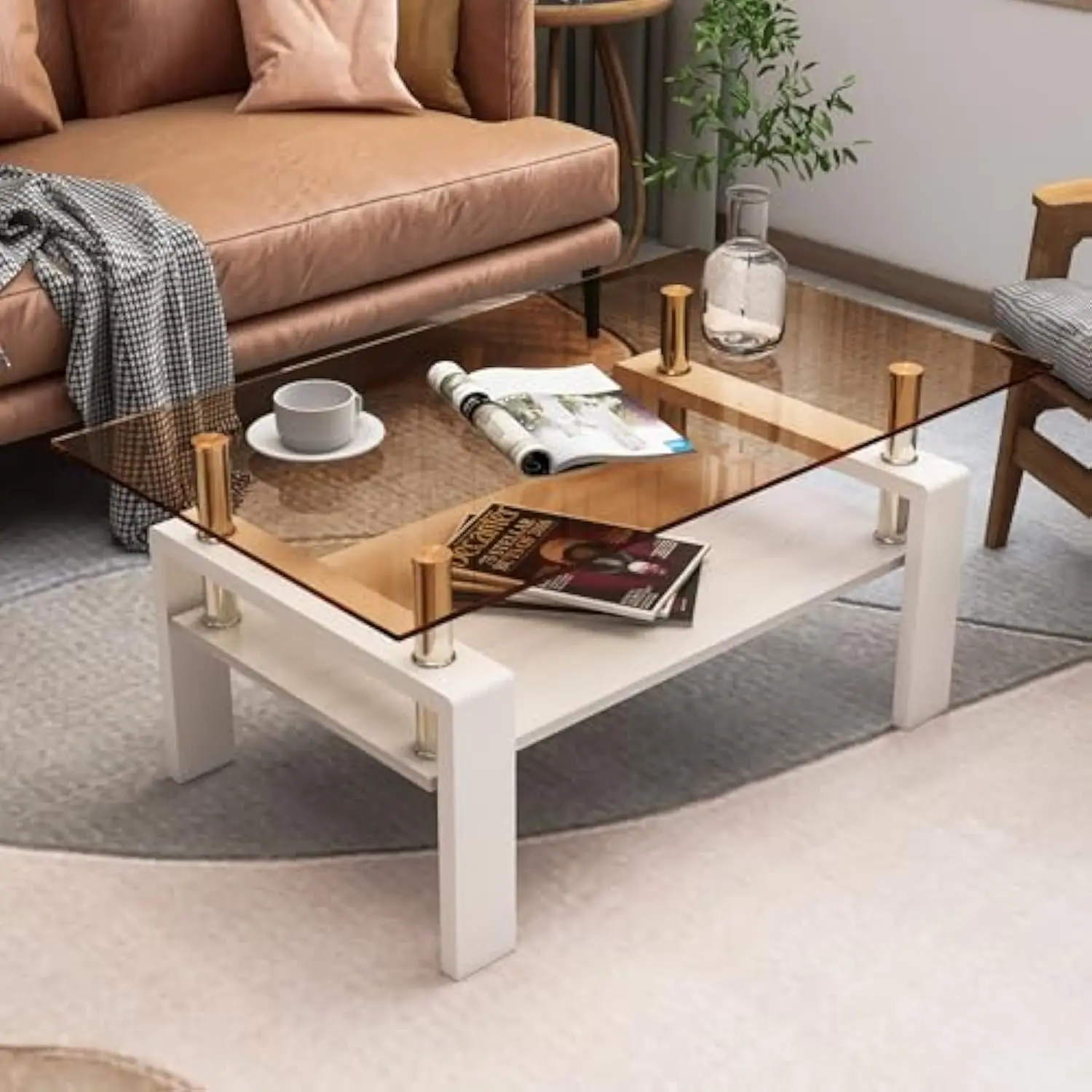
III. Shapes and Configurations That Optimize Space
The shape of your nesting tables significantly impacts how they function in limited spaces:
Round/Oval Tables:
Round nesting tables excel in tight spaces by eliminating sharp corners that can catch hips or shins. This safety feature is particularly valuable in high-traffic areas or rooms where people frequently navigate around furniture. The gentle curves of mid-century modern round coffee tables promote smoother traffic flow, making them ideal for central room positions.
Oval designs combine the benefits of round tables with slightly more surface area, offering an excellent middle ground between circular and rectangular options. The design features of oval shaped tables include tapered ends that allow for easier passage in narrow spaces while still providing generous surface area.
Square/Rectangular Tables:
These geometric options maximize usable surface area and fit perfectly against walls or in corners. Their straight edges align neatly with sofas and chairs, creating cleaner visual lines in the room. When nesting, square and rectangular tables can create interesting staggered arrangements when partially pulled out.
C-Shaped and Asymmetrical Designs:
Perhaps the most space-efficient configuration, C-shaped tables can slide directly over seating, eliminating the need for clearance space around them. These clever designs function as laptop tables, eating surfaces, or work areas without requiring additional room for placement.
Strategic Configuration Options:
The best nesting table sets allow for multiple arrangements:
– Complete nesting for maximum floor space
– Staggered configurations for layered surfaces
– Fan-like arrangements for entertaining
– Separate placement throughout a room for distributed functionality
When selecting shapes, consider not just the room’s dimensions but how people move through the space. Round tables work well in central locations or tight corners, while rectangular pieces excel against walls or as space dividers in open floor plans.
IV. Size Variations and Proportions
Understanding the standard size ranges helps ensure your nesting tables will fit appropriately in your space:
Coffee Table Nesting Sets:
– Large table: 30-36 inches in diameter/length, 16-19 inches high
– Medium table: 24-30 inches in diameter/length, 14-17 inches high
– Small table: 18-24 inches in diameter/length, 12-15 inches high
Side/End Table Nesting Sets:
– Large table: 20-24 inches in diameter/length, 20-24 inches high
– Medium table: 16-20 inches in diameter/length, 18-22 inches high
– Small table: 12-16 inches in diameter/length, 16-20 inches high
The height variations within sets serve practical purposes beyond just nesting capability. Different heights accommodate various activities—lower tables for casual drinks, higher ones for eating or working. This functional diversity makes mid-century modern small coffee tables particularly valuable in compact spaces.
Proportional graduation between pieces is crucial for both aesthetic appeal and functionality. The ideal proportion maintains approximately 2-4 inches difference in width/length and 1-3 inches in height between consecutive tables. This creates visual harmony while ensuring each piece is still useful on its own.
When measuring your space for nesting tables, consider:
– The footprint of the largest table when fully extended
– Clearance needed around the tables when in use
– Height in relation to surrounding seating
– Space required for full extension of all tables
Proper proportions not only ensure better nesting but also create more pleasing visual relationships between the pieces when they’re deployed throughout your space.
V. Functional Features Enhancing Versatility
What truly sets exceptional nesting tables apart is their multifunctional design elements that maximize utility in limited spaces:
Multi-level Functionality:
The varied heights within a nesting set create natural tiers for different activities. Lower tables work perfectly for casual drinks and snacks, middle heights serve as ideal laptop surfaces, while taller pieces can function as impromptu dining surfaces. This height variation allows you to unlock home entertaining possibilities by creating multi-level displays or serving stations from a single furniture set.
Modularity Benefits:
Quality nesting tables can be reconfigured in numerous ways:
– Fully nested to maximize floor space
– Partially nested with staggered surfaces for layered displays
– Completely separated to serve different areas of a room
– Arranged in clusters for larger gatherings
– Positioned at different heights around seating for accessibility
Additional Storage Features:
Some nesting table designs incorporate clever storage solutions:
– Hidden drawers in the largest piece
– Open shelving beneath tabletops
– Magazine racks integrated into frames
– Small compartments for remote controls or coasters
Mobility Enhancements:
The ability to easily move these tables amplifies their space-saving potential. Look for:
– Lightweight construction materials
– Optional casters on larger pieces
– Smooth bottoms that glide across flooring
– Integrated handles or easily grippable edges
These functional elements multiply the utility of nesting tables far beyond what their compact size might suggest. By investing in versatile pieces, you can maximize living spaces with space-saving coffee tables without sacrificing functionality or style.
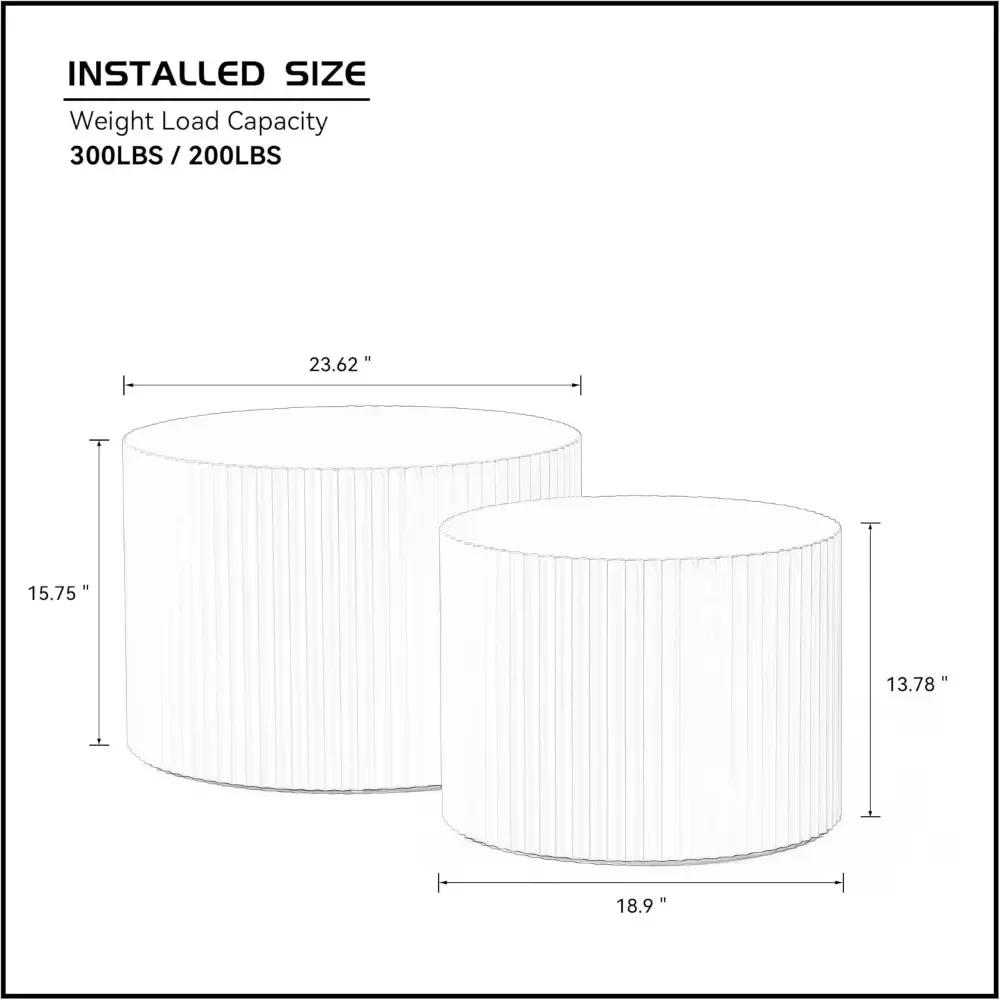
VI. Aesthetic Features That Influence Space Perception
Beyond physical space-saving, thoughtfully designed nesting tables can actually make a room feel larger through visual tricks and optical illusions:
Minimalist and Streamlined Design:
Clean lines and uncluttered silhouettes reduce visual noise that can make spaces feel cramped. The simplicity often found in mid-century nesting coffee tables exemplifies this approach—focusing on essential elements while eliminating unnecessary ornamentation. This visual restraint gives the eye restful areas, making rooms feel more spacious.
Leg Design Impact:
The style of table legs dramatically affects spatial perception:
– Hairpin or tapered legs create negative space underneath, allowing the eye to travel through the furniture
– Pedestal bases provide clean lines with minimal visual obstruction
– Splayed legs offer stability while maintaining visual lightness
– Clear acrylic legs virtually disappear, creating floating surfaces
Color Selection Strategies:
Light-colored tables generally make spaces feel more open by reflecting more light. However, strategic use of darker tones can create depth and dimension. The contrast between dark bases and lighter tops can help define functional zones without physical barriers.
Finish Options and Light Reflection:
High-gloss finishes reflect light, enhancing brightness in small spaces. Matte finishes reduce glare but can add visual warmth. Metallic accents introduce points of light reflection that add dimension without requiring additional space.
Mid-century Modern Principles:
This design style naturally enhances spaciousness through:
– Organic forms that guide the eye smoothly through spaces
– Functional simplicity that avoids clutter
– Balanced proportions that create harmony
– Elevated designs that maintain sight lines across rooms
When these aesthetic elements work together, they create tables that don’t just save physical space—they actively make rooms feel more expansive and harmonious.
VII. How to Select Nesting Tables for Different Spaces
Choosing the right nesting tables requires considering the specific needs of each room type:
Small Living Rooms:
Priority features for living spaces include:
– Proper height relationship with seating (generally 1-2 inches lower than couch cushions)
– Shapes that complement traffic patterns (round for central placement, rectangular for against walls)
– Proportions that balance the visual weight of other furniture
– Materials that coordinate with existing design elements
Bedrooms:
In sleeping areas, look for:
– Smaller footprints that fit in limited nightstand space
– Heights appropriate for reaching from bed
– Soft edges or rounded corners for safety
– Quieter materials that won’t create noise when nested/unnested
– Light construction for easy movement during cleaning
Home Offices:
For productive work areas, prioritize:
– Sturdy construction that supports computer equipment
– Heights suitable for typing or writing (generally 26-30 inches)
– Materials resistant to heat from electronics
– Clean, simple designs that reduce visual distraction
– Sufficient surface area for work materials
Open-Concept Areas:
In multi-functional open spaces:
– Use nesting tables as flexible zone dividers
– Select versatile pieces that can serve multiple functions
– Choose styles that bridge different design elements
– Consider mobility features for quick reconfiguration
When space is extremely limited, exploring small space coffee table alternatives might reveal innovative solutions beyond traditional nesting sets, such as convertible or wall-mounted options.
Mid-Century Modern Nesting Side & End Tables, Mid-Century Modern Nesting Table Sets, Mid-Century Modern Round Side & End Tables
Price range: $239.35 through $273.06 Select options This product has multiple variants. The options may be chosen on the product pageMid-Century Modern Glass Top Coffee Tables, Mid-Century Modern Glass Top Side & End Tables
$460.58 Select options This product has multiple variants. The options may be chosen on the product pageMid-Century Modern Glass Top Coffee Tables, Mid-Century Modern Vintage Coffee Tables, Mid-Century Modern Vintage Side & End Tables
$725.36 Select options This product has multiple variants. The options may be chosen on the product pageMid-Century Modern Nesting Coffee Tables, Mid-Century Modern Nesting Table Sets
$361.45 Select options This product has multiple variants. The options may be chosen on the product pageMid-Century Modern Nesting Table Sets, Mid-Century Modern Round Coffee Tables
$462.57 Select options This product has multiple variants. The options may be chosen on the product pageMid-Century Modern Round Coffee Tables, Mid-Century Modern Small Coffee Tables
$452.73 Select options This product has multiple variants. The options may be chosen on the product page
VIII. Maintenance and Durability Considerations for Space-Efficient Tables
The longevity of your nesting tables directly affects their value as space-saving solutions—frequent replacements waste both money and space. Invest in quality pieces that will endure years of use:
Material-Specific Maintenance:
Glass/Acrylic Care:
– Clean with non-abrasive, ammonia-free cleaners
– Use microfiber cloths to avoid scratching
– Check and tighten support hardware regularly
– Avoid placing hot items directly on surfaces
Wood Care:
– Dust regularly with soft cloth
– Apply appropriate wood conditioner quarterly
– Protect from direct sunlight to prevent fading
– Use coasters and placemats to prevent rings and scratches
Metal Care:
– Wipe clean with damp cloth
– Apply metal polish appropriate for the specific finish
– Check for loose connections or wobbling legs
– Touch up any chips in painted finishes promptly
Space-Conscious Storage of Supplies:
Store cleaning supplies in compact containers that can be tucked away in small cabinets. Multi-purpose cleaners reduce the need for multiple products.
Quality Indicators for Lasting Performance:
– Smooth nesting action without catching or scraping
– Consistent finish quality on visible and hidden surfaces
– Solid joinery with minimal visible hardware
– Even leg heights that prevent wobbling
– Appropriate weight for the materials used
With proper care, quality nesting tables can last 10-15 years or more, making them a smart investment for space-conscious homes. The average wood set lasts 15+ years with proper care, while glass and metal combinations typically endure 10+ years before showing significant wear.
Styling Space-Efficient Nesting Tables: Maximize Function and Appeal
Creating beautiful arrangements with nesting tables doesn’t require sacrificing their space-saving benefits. Consider these balanced approaches:
Decorative Strategies:
– Select varied heights for visual interest when displaying items
– Group objects in odd numbers (3 or 5 pieces) for balanced composition
– Use trays to corral small items, allowing for quick clearing
– Layer textures rather than accumulating numerous objects
– Choose dual-purpose decorative items that also serve functions
Seasonal Adjustment Techniques:
– Rotate decorative items rather than adding more during holidays
– Use lightweight, collapsible decor that stores easily when not in use
– Select multi-season pieces that require fewer changes
– Consider digital photo frames instead of multiple framed pictures
Multifunctional Styling Ideas:
– Decorative boxes that provide hidden storage
– Beautiful books that offer both display and entertainment
– Sculptural pieces that double as bookends
– Stylish coasters that protect surfaces while adding visual interest
The key is maintaining breathing room around display items. A good rule of thumb: leave at least 50% of the surface clear for practical use. This approach creates visual appeal without compromising the tables’ functionality or creating a cluttered appearance.
The exceptional designs of nesting coffee tables allow for creative styling while maintaining their practical benefits, proving that space efficiency and beautiful design are perfectly compatible goals.
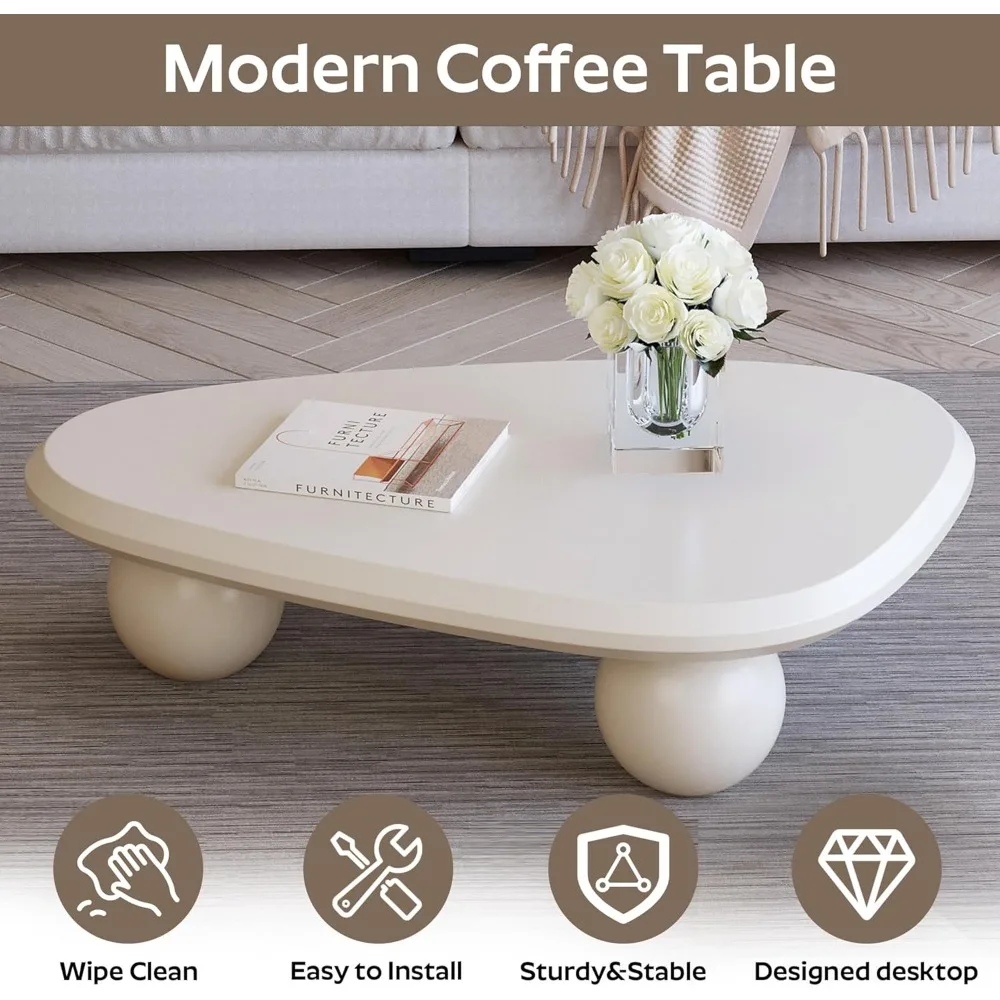
Are Nesting Tables Worth the Investment for Small Spaces?
When considering the value proposition of nesting tables for compact living, several factors come into play:
Cost-Benefit Analysis:
Quality nesting table sets typically range from $200-$600, depending on materials and craftsmanship. While this may initially seem higher than some individual tables, the versatility factor must be considered. A well-made nesting set effectively provides 2-3 tables for the price and footprint of one larger piece.
Long-Term Value:
The space-saving benefit compounds over time in small living environments. The ability to adapt to changing needs without purchasing additional furniture creates lasting value beyond the initial price point.
Maximum Return on Investment Scenarios:
Nesting tables provide the greatest value in:
– Studios and one-bedroom apartments
– Multi-purpose rooms serving several functions
– Homes with frequent entertaining needs
– Spaces with fluctuating occupancy
– Rooms where furniture must be frequently reconfigured
Alternative Considerations:
In some situations, other options might serve better. For instance, when comparing nesting vs. folding coffee tables, folding tables might be preferable for extremely tight spaces where even nested tables take up too much room when not in use. However, folding tables typically offer less stability and aesthetic appeal.
For most small space dwellers, the versatility, adaptability, and style of well-designed nesting tables make them a worthwhile investment that pays dividends in both functionality and comfort. Their ability to grow and shrink with your needs represents a uniquely valuable feature in the world of space-conscious furniture.

